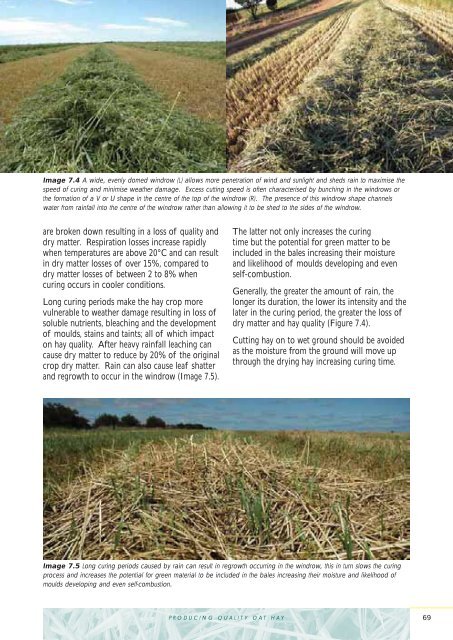You also want an ePaper? Increase the reach of your titles
YUMPU automatically turns print PDFs into web optimized ePapers that Google loves.
Image 7.4 A wide, evenly domed windrow (L) allows more penetration of wind and sunlight and sheds rain to maximise the<br />
speed of curing and minimise weather damage. Excess cutting speed is often characterised by bunching in the windrows or<br />
the formation of a V or U shape in the centre of the top of the windrow (R). The presence of this windrow shape channels<br />
water from rainfall into the centre of the windrow rather than allowing it to be shed to the sides of the windrow.<br />
are broken down resulting in a loss of quality and<br />
dry matter. Respiration losses increase rapidly<br />
when temperatures are above 20°C and can result<br />
in dry matter losses of over 15%, compared to<br />
dry matter losses of between 2 to 8% when<br />
curing occurs in cooler conditions.<br />
Long curing periods make the hay crop more<br />
vulnerable to weather damage resulting in loss of<br />
soluble nutrients, bleaching and the development<br />
of moulds, stains and taints; all of which impact<br />
on hay quality. After heavy rainfall leaching can<br />
cause dry matter to reduce by 20% of the original<br />
crop dry matter. Rain can also cause leaf shatter<br />
and regrowth to occur in the windrow (Image 7.5).<br />
PRODUCING QUALITY OAT HAY<br />
The latter not only increases the curing<br />
time but the potential for green matter to be<br />
included in the bales increasing their moisture<br />
and likelihood of moulds developing and even<br />
self-combustion.<br />
Generally, the greater the amount of rain, the<br />
longer its duration, the lower its intensity and the<br />
later in the curing period, the greater the loss of<br />
dry matter and hay quality (Figure 7.4).<br />
Cutting hay on to wet ground should be avoided<br />
as the moisture from the ground will move up<br />
through the drying hay increasing curing time.<br />
Image 7.5 Long curing periods caused by rain can result in regrowth occurring in the windrow, this in turn slows the curing<br />
process and increases the potential for green material to be included in the bales increasing their moisture and likelihood of<br />
moulds developing and even self-combustion.<br />
69

















